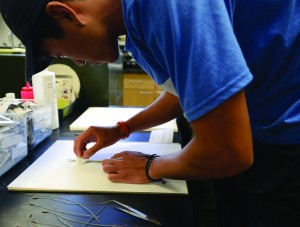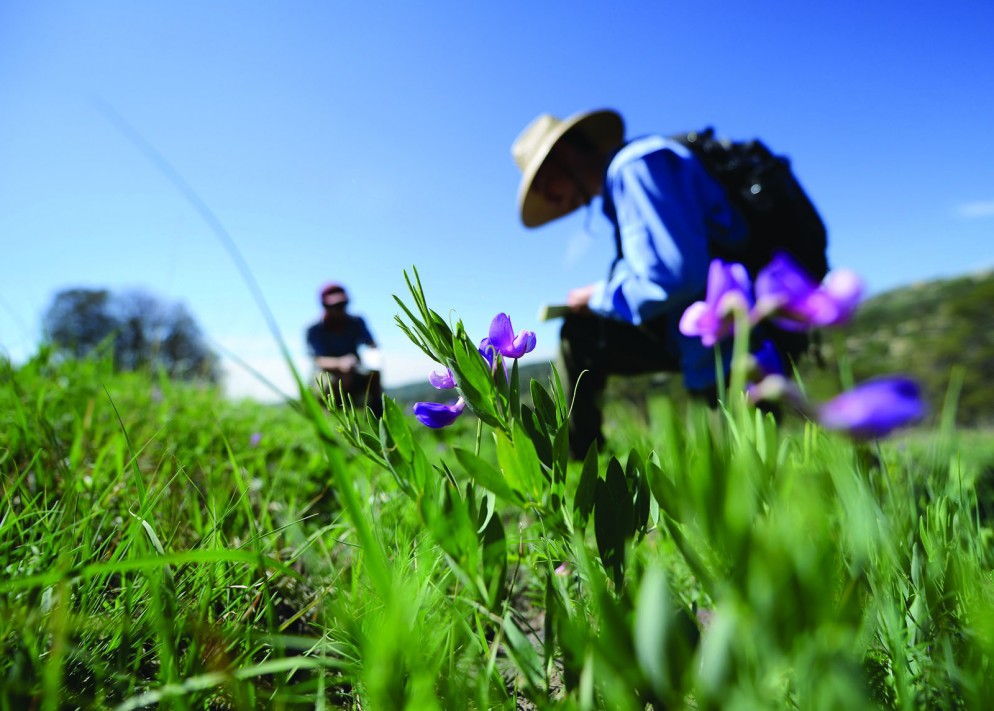CC’s Carter Herbarium and the Botanists Who Put the Pikes Peak Region on the Map
What makes the Pikes Peak region special? Some say it’s the spectacular mountain peaks or the vivid red rocks. But although gazing at peaks and climbing on rocks have their charms, there is something to be gained by stopping, putting hands and knees on earth, and looking closely at the plants growing here.
They’re quite remarkable.
Pikes Peak dominates a diverse bioregion that stretches from alpine tundra to desert grasslands, according to “Botany of the Pikes Peak Region,” by Tass Kelso. That means you can see the miniature blue flowers of alpine forget-me-not in the tundra, the spiny cholla cactus standing proudly on the dry mesa, and the iridescent New Mexico feathergrass waving in the breeze in the grasslands — all in the same day.
This quality has drawn nationally known botanists to the region, and to Colorado College, since the 1880s. Kelso, a professor of biology who has taught botany at CC since 1987, is the most recent in this distinguished line of botanists attracted by the region’s biodiversity and the opportunity for scientific exploration at CC.
“A uniform landscape holds far less appeal than one of rich texture and topography. Our native species shape the unique visual texture of this place: the mahogany of shrub lands against a fall sky, silhouettes of grama grass and pronghorns on the plains, bright color against a dark forest background from summer wildflowers like columbines, geraniums, locoweeds, and asters,” said Kelso. The spirit of botanical discovery has both taken root and blossomed on campus.
The Carter Herbarium of Colorado College, in Barnes Science Center, is named for longtime Biology Professor Jack Carter, who began teaching at CC in 1968. The herbarium’s collection includes more than 15,000 specimens of plants primarily from eastern Colorado, but also from surrounding states and regions.
CC professors, students, alumni, and botanists from around the region have all contributed to this collection, which contains important specimens and records for the State of Colorado.
The herbarium’s research focus is the flora of the Pikes Peak region, which includes El Paso, Teller, Pueblo, and Fremont counties. A flora treatise of the Pikes Peak region is being developed based on local fieldwork over the past 20 years, and plant records from this herbarium and regional herbaria such as those at University of Colorado, Colorado State University, and the University of Wyoming.
Early CC botanists and the creation of the herbarium
As the exceptional nature of the plant life of the Pikes Peak region became known, national figures became interested in “botanizing” in the area and often mentored locals and CC students. Frederic Clements, a leader among these nationally famous botanists, established the Pikes Peak Research Station that did much to publicize local ecology.
Clements mentored Colorado Springs native and CC student Homer Shantz, who went on to write his dissertation on the unique grasslands of the Colorado Springs mesas. Shantz appears to have been a professor at CC (records for this era, around the 1930s, are spotty) and also became the leading grassland expert in the U.S., especially during the Dust Bowl days. Robert Livingston, a CC student around 1938, did his master’s and Ph.D. theses about the Black Forest area and became a leading botanist at the University of Massachusetts.
Professor T.D.A. Cockerell was one of the leading biologists in Colorado, with expertise in multiple aspects of botany and zoology, and curated the CC Museum in 1903-04. William “Bill” Penland became professor of botany at CC in 1922 and was the first known director of the herbarium. He was responsible for its original expansion and for its contributions to the botany of Colorado and elsewhere.
Under Jack Carter, now professor emeritus of biology, the herbarium flourished and expanded. Carter was professor and curator of the herbarium from 1968 to 1989.
Carter, 85, is retired and lives in southern New Mexico, where he and his wife, Martha, keep busy writing books, conducting plant workshops, and maintaining their solar-powered home and large property adjacent to the Gila National Forest. His “Trees and Shrubs of New Mexico” (featured in “On the Bookshelf” in the November 2013 Bulletin) was published in 2012 and is “selling well,” according to Carter. Martha Carter ’70 was an elementary teacher for many years in Widefield District 3 before she retired and joined Jack as a partner in his botanical research, education, and writing.
Because their years at Colorado College were such an important part of their lives, upon retirement Martha and Jack decided to make a long-term commitment to the teaching of the plant sciences and the Carter Herbarium. They established an endowed fund, which provides some support for the herbarium and for students to conduct ecological and plant conservation research.
The herbarium today
Plant science classes are popular among CC students and, although field study is essential to the study of botany, the herbarium is its hub on campus. Courses that are directly involved with the herbarium include Biology of Plants, Field Botany, Ecology, Conservation Biology, Research in Biology, and Advanced Field Techniques.
Students in Tass Kelso’s Advanced Field Methods class worked this summer on mapping the plant communities in a newly acquired parcel of parkland in northwest Colorado Springs, using both a “boots on the ground” assessment and the modern technological tools of GPS and Geographic Information Systems (GIS) mapping. In the laboratory and the Colorado College GIS lab, collaborating with Matt Gottfried, technical director of the lab, students developed a report on parkland vegetation that will play an integral role in the City of Colorado Springs’ management plan for Ute Valley Park.
The city is just one of many entities that look to Colorado College for botanical data. Through the work of CC faculty and students, the herbarium has contributed research and information to agencies including the U.S. Forest Service, the Bureau of Land Management, and The Nature Conservancy.
“The herbarium is part and parcel of what CC has done from its inception, and students and faculty are carrying on with this important work,” said Kelso, the current curator of the Carter Herbarium. Kelso and Carter also acknowledged Carolyn Noble, botany staff assistant, for her nearly 40 years of service.
“Carolyn has been extremely helpful in many aspects of managing the herbarium, including working with students,” said Kelso.
“She was always an important assistant in teaching the students to prepare excellent herbarium sheets and in maintaining the quality of the herbarium. Beyond the herbarium, Carolyn was responsible for the greenhouses and preparing materials for the botany teaching laboratory. I don’t know what we would have done without her,” Carter said.
Many students who worked in the herbarium under Carter and Kelso have made plant science a part of their careers.
“I want to acknowledge how important the students have been as they became interested in the herbarium, in producing quality herbarium materials and conducting field research and ecological studies,” Carter said. “As I looked over my list of students that I can recall who continued their studies in the plant sciences and ecology to become professors, herbarium curators, plant illustrators, teachers, and outstanding plant science writers, I wish I could thank each of them personally for what they have contributed to my life.”
A Library of Plants
 A herbarium is a collection of plant specimens that have been dried and pressed. They are arranged in an evolutionary sequence and by family with labels including the scientific name and considerable information describing the specimen and the environment in which it was collected.
A herbarium is a collection of plant specimens that have been dried and pressed. They are arranged in an evolutionary sequence and by family with labels including the scientific name and considerable information describing the specimen and the environment in which it was collected.
According to Jack Carter, professor emeritus of biology, herbaria are important because plant collections can help describe the ecological history of an area. At the same time, they can help chart the present, past, and potential impact of humans over time. And with the associated history of the climate and physical characteristics of the soils and weather, the herbarium can be used to help predict the future.
“A herbarium grows in value with each passing year and with the addition of each new plant record. For example, this is one of the most trusted methods for following the migration of species,” said Carter.
He said herbaria also can be instrumental in identifying areas needing protection. Each collected plant species may be used to identify the plant species in a particular ecosystem. These also may include political boundaries, biological life zones, geological histories, and also parks, national forests, and prairies.
“These are areas that now and into the future need protection,” said Carter.
For information about the herbarium or to visit, contact tkelso@coloradocollege.edu or (719) 389-6405.
